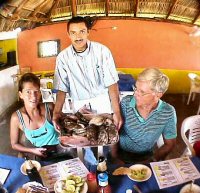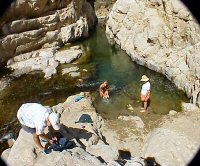 Flowing, crashing, splashing...the waterfall in El Salto just north
of Manzanillo is the principal waterfall in the state. It is more than 100 feet in height,
and is formed by the Minatitlán-Marabasco River. Flowing, crashing, splashing...the waterfall in El Salto just north
of Manzanillo is the principal waterfall in the state. It is more than 100 feet in height,
and is formed by the Minatitlán-Marabasco River.
 The drive from Manzanillo to El Salto takes only about
50 minutes,
although you'll
feel like you've gone back millions of years in time. Around every turn you expect to see
a dinosaur right out of "Jurassic Park." Getting there is half the
fun--driving through jungles and tropical rain forests, on a winding mountain road where
you cross the river several times. You'll pass several little Mexican pueblos,
or villages (with speed bumps), so don't be surprised if you see people riding burros, and keep your eye
peeled for cattle, dogs, goats or pigs in the road. The drive from Manzanillo to El Salto takes only about
50 minutes,
although you'll
feel like you've gone back millions of years in time. Around every turn you expect to see
a dinosaur right out of "Jurassic Park." Getting there is half the
fun--driving through jungles and tropical rain forests, on a winding mountain road where
you cross the river several times. You'll pass several little Mexican pueblos,
or villages (with speed bumps), so don't be surprised if you see people riding burros, and keep your eye
peeled for cattle, dogs, goats or pigs in the road.
 One small,
immaculate village, Peña Colorada, was built
especially for the iron mine workers. You'll see the mine at the top of the mountain,
named Los Juanes. One small,
immaculate village, Peña Colorada, was built
especially for the iron mine workers. You'll see the mine at the top of the mountain,
named Los Juanes.
The blue pipeline you see along the road is used to transport iron
ore (by flowing water) to the pelletizing plant 37 miles away in Manzanillo.
It is recycled back to the mine by the smaller blue pipe.
  Just past the
immaculate town of Peña Colorada is the entrance to El Salto. As you turn right down a cobblestone
drive, you'll see huge parota trees, adorned with strangler vines
you can swing from (if you're the Tarzan type). There is a 10 peso charge
per person that goes to benefit DIF, which is a government-sponsored
program for poor families. Once in the new park, walk around and enjoy the
many different types of trees and flowering shrubs. The most prolific are
the coffee trees (beans change from green to red-brown to black). Colima
coffee has won awards world wide. Behind one of the small stands selling Chiclets,
is a living "chicle" tree. Ask to see it, and you'll get
a sample of raw Chiclet gum. (Not very tasty, but interesting.) Another
tree of interest is the "tourist tree." This tree has red,
peeling bark, just like--you guessed it--a sunburned tourist! Just past the
immaculate town of Peña Colorada is the entrance to El Salto. As you turn right down a cobblestone
drive, you'll see huge parota trees, adorned with strangler vines
you can swing from (if you're the Tarzan type). There is a 10 peso charge
per person that goes to benefit DIF, which is a government-sponsored
program for poor families. Once in the new park, walk around and enjoy the
many different types of trees and flowering shrubs. The most prolific are
the coffee trees (beans change from green to red-brown to black). Colima
coffee has won awards world wide. Behind one of the small stands selling Chiclets,
is a living "chicle" tree. Ask to see it, and you'll get
a sample of raw Chiclet gum. (Not very tasty, but interesting.) Another
tree of interest is the "tourist tree." This tree has red,
peeling bark, just like--you guessed it--a sunburned tourist!
  There
new water park has 3 pools, a large 3-story water slide, and two smaller "kiddy"
slides. The water that feeds the pools comes straight from the spring-fed
creek, so it's cool and crystal clear. Can you imagine the pleasure of swimming in a fresh
water pool without chlorine? (This water is recycled back into the creek
below after flowing through the pools by gravity feed.) There
new water park has 3 pools, a large 3-story water slide, and two smaller "kiddy"
slides. The water that feeds the pools comes straight from the spring-fed
creek, so it's cool and crystal clear. Can you imagine the pleasure of swimming in a fresh
water pool without chlorine? (This water is recycled back into the creek
below after flowing through the pools by gravity feed.)
 If you want to get to
the waterfall, you have to drive past the new water park to the If you want to get to
the waterfall, you have to drive past the new water park to the bottom of
the hill. There's a shaded parking area. One
sign reads "Cascadas" (waterfall), and it points to you an iron
bridge. Stop in the middle of the bridge and look left, and you'll see a
smaller waterfall that always has clean, clear spring water. After
crossing the bridge, follow the sidewalk that leads through another older picnic area to the spectacular falls. Trek down the concrete steps and take a
swim in the refreshing pool at its base, which at times, is over your head in places.
Float down the high-walled canyon to the other side where another pool awaits. To your
right, after the canyon, is a small grotto to explore, and about 1,500 feet further down the creek is another
smaller waterfall. bottom of
the hill. There's a shaded parking area. One
sign reads "Cascadas" (waterfall), and it points to you an iron
bridge. Stop in the middle of the bridge and look left, and you'll see a
smaller waterfall that always has clean, clear spring water. After
crossing the bridge, follow the sidewalk that leads through another older picnic area to the spectacular falls. Trek down the concrete steps and take a
swim in the refreshing pool at its base, which at times, is over your head in places.
Float down the high-walled canyon to the other side where another pool awaits. To your
right, after the canyon, is a small grotto to explore, and about 1,500 feet further down the creek is another
smaller waterfall.
 Back
at the parking area there is another sign that says "Cuevas,"
(caves). Follow that trail, and you'll come to another part of the creek.
Sometimes in summer, the cave is inaccessible, but during the winter
months you can walk through to the other side. Another waterfall is just a
short walk away downstream, but it's a good idea to wear some type of
"Water-friendly" shoes, as sometimes you're walking in water,
and the bottom is muddy. Back
at the parking area there is another sign that says "Cuevas,"
(caves). Follow that trail, and you'll come to another part of the creek.
Sometimes in summer, the cave is inaccessible, but during the winter
months you can walk through to the other side. Another waterfall is just a
short walk away downstream, but it's a good idea to wear some type of
"Water-friendly" shoes, as sometimes you're walking in water,
and the bottom is muddy.
 On
Saturdays and Sundays, tacos and snacks are sold at the park, but if you come on any other
day, bring your lunch and have a picnic. Spread a blanket on a rock, or chose one of the
many picnic tables, complete with barbecue grills. They also allow overnight
camping. On
Saturdays and Sundays, tacos and snacks are sold at the park, but if you come on any other
day, bring your lunch and have a picnic. Spread a blanket on a rock, or chose one of the
many picnic tables, complete with barbecue grills. They also allow overnight
camping.
Don't care to rough it? Go on about 10
minutes more to the small town of Minatitlán and have delicious cocina Mexicana
(Mexican food) in a little restaurant called "La Herradura."
 If seafood is more to your liking, try the restaurant "El Caminero,"
in Camotlan de Miraflores (right at the speed bump) on the road back home.
If seafood is more to your liking, try the restaurant "El Caminero,"
in Camotlan de Miraflores (right at the speed bump) on the road back home.
The waterfall is not a tourist trap, and for the most part, Sunday
is usually the only day when you'll see other people there. It's one of the few places
still left untouched by civilization, and is a must to see when you visit Manzanillo.
 Depending
on the time of the year, the waterfall is very different. During rainy
season (June through October), it is huge and powerful, with muddy
water flowing down the creek. Oftentimes it is closed and you are not
allowed to swim there. But come November through May, El Salto is mild and
its waters are crystal clear. Depending
on the time of the year, the waterfall is very different. During rainy
season (June through October), it is huge and powerful, with muddy
water flowing down the creek. Oftentimes it is closed and you are not
allowed to swim there. But come November through May, El Salto is mild and
its waters are crystal clear.
 During
the summer months, when you can't swim at the base of the falls, cross the
bridge and to your right you'll see a dilapidated building that used to be
a restaurant. Follow the foot path, and you'll find a ladder that used to
be part of the slide in the old park. Go down the ladder and continue on
the trail, and you'll reach the lower pool. Even in the summer, it is
usually safe to swim there. During
the summer months, when you can't swim at the base of the falls, cross the
bridge and to your right you'll see a dilapidated building that used to be
a restaurant. Follow the foot path, and you'll find a ladder that used to
be part of the slide in the old park. Go down the ladder and continue on
the trail, and you'll reach the lower pool. Even in the summer, it is
usually safe to swim there. For
more information about a tour to the waterfalls, write: susan@gomanzanillo.com
or go to this
link. The
180-page tourist guide "Manzanillo and the state of Colima, Facts,
Tips & Day Trips," contains information on this adventure and
many more. Go
to: www.gomanzanillo.com/guidebook/index.htm |













